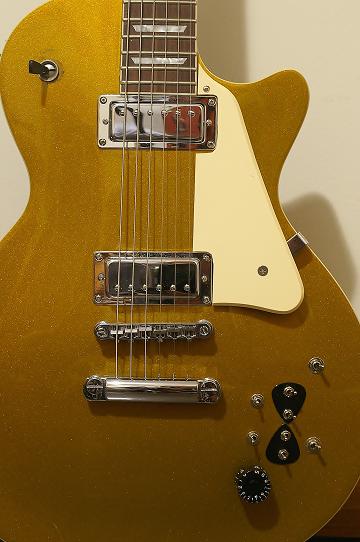|
Besides the electronics of rewiring, there are many choices you can make to change the appearance
of the guitar as well. | For example, you can use different kinds of switches and even guitar picks . 
In the above graphic, the guitar already has two holes drilled into it, creating a problem for your latest rewiring. One hole is much larger than the other and if you wanted to install two very small switches, the hole on the right is much too large. Yes, you could try securing the switch with a large washer above and below the wood but a small switch with a large washer might look cheap and cheesy, plus the fact that a switch mounted in that way would not be very secure. There is another solution though. Get a guitar pick and drill into it two small holes, the same size as the hole on the left. Place the left side switch in the hole already drilled in the guitar then place the guitar pick on that switch and secure it with the nut. (You will probably not be able to squeeze in the switch washer because of the thickness of the guitar pick). Now place the right hand switch into the guitar and tighten the switch nut onto the guitar pick. Now both switches have been firmly secured. The left switch is secured to the guitar wood and the guitar pick and the right side switch is secured only to the guitar pick but it is quite strong. I have done this many times (see the photos), and the pick is extremely secure. Don't forget that a guitar pick is very strong and this is something you should also keep in mind when you drill into them. These photos might give you some ideas.
 
The guitar on the above left is a Yamaha SBG 2000, sometimes referred to as the "Japanese Les Paul". Like the Les Paul, it weighs a lot and has tremendous sustain. Those formidable looking pickups are DiMarzio X2N's, the highest output pickup made by any manufacturer. Despite their incredible output, with the proper switching, you can get very bright sounds out of those X2N's and I sometimes jokingly refer to this as my "surf guitar". Yes there are eight switches on this guitar because I added a solo switch to the Super Seven Switching. That's a red rocker switch for the phase switch chosen just because I like the look of it. |
|
| |
  | |
|
The guitar (above left) is an OLP MM1. Six of the switches are mounted on guitar picks. Why? The picks cover up holes that were drilled into the guitar (either originally or later) and the guitar picks are strong enough to support a switch even if there is no wood surrounding that one switch. Above right is a Gibson SG Standard with 2 switches mounted on a guitar pick and 4 others mounted on a brass plate. The phase switch is a red rocker switch. Yes, a regular toggle would do the job just as well, but the rocker switch looks kind of impressive doesn't it? | |
|
| |
  | |
| Above are 2 Steinberger Spirit guitars.
Despite their appearance, those are full-sized guitars and are very well made.
The guitar on the left has 2 DiMarzio X2N's which as stated previously, have extremely high output without being muddy. The guitar on the right has 2 DiMarzio Super III's which have a fuller, darker, "crunchier" sound especially when distorted. Both guitars have eight switches - I added a "solo switch" to the Super Seven Switching. | |
  | |
|
Above are 2 Dean Guitars, with a Vendetta XM on the left, and an Evo XM on the right.
These guitars are very inexpensive (just slightly over $100) and are an incredible bargain.
The Vendetta XM underwent a pickup change recently with the originals being replaced by two inexpensive humbuckers found with an Internet search. The Evo XM has a DiMarzio X2N in the bridge position and a Dimarzio Super II in the neck position. Although the Super II is still available, that particular style is no longer manufactured. The Super II was a favorite of legendary guitar player Jerry Garcia.
| |
 | |
|
For Super Seven Switching™ you don't need two true humbucking pickups. Pictured above is a guitar made in the style of the Fender Telecaster™ and manufactured by the now out of business Route 101 Guitars. The neck pickup is a true humbucker and the other "humbucker" consists of the middle and bridge single coils. It may look as if there isn't much room in that guitar cavity but seven switches can be mounted there. There is enough room to have both the volume and tone control installed, but lately (as can be seen in the above photographs) I've just been installing tone controls on guitars. Not installing volume controls was my decision and in fact they do serve a useful purpose particularly if you are appearing on stage. However, that is the fun of modifying guitars - you can wire it in exactly the way you want. |